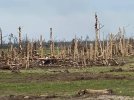Here's some anchor bolt pics from Greenfield btw.
1. Bent anchors similar to the Diaz EF4 home. This is also before clean up so we know the tornado caused it.
View attachment 36727
2. Never noticed the anchors in this foundation before because most of the perimeter has been scoured away. You can see them in the bottom right corner of the first pic. One wall has the sill stripped, the other with the sill still attached.
View attachment 36730View attachment 36728
3. More stripped and bent anchor bolts on a much more modern house. Pic is from post clean-up, which is why I never share it, but am realizing now it's still important for painting the bigger picture.
View attachment 36735View attachment 36737
4. Hard to find anchors when the whole foundation is scoured.
View attachment 36731
5. Another slab (pre-cleanup) with anchors, multiple of which have been bent or pulled out of the ground.
View attachment 36740
6. These parking bollards were anchored. We've seen moved parking bollards, but never snapped, anchored bollards.
View attachment 36733
7. People were so impressed by the snapped Diaz foundation, but what about this snapped, car-sized chunk of foundation that was ALSO thrown?
View attachment 36734
8. The caked grass and mud on the front of this house and the snapped foundation (back right) gives some context clues into how powerful these winds were.
View attachment 36738
Each individual DI observed in a vacuum may not be enough to prove EF5 winds, but the collective evidence paints a much clearer picture. The satellite imagery of the scar through town, the snapped bollards, the bent and missing anchor bolts, and the scoured slabs and foundations are individually the most extreme contextuals of their type we've ever seen (certainly from an EF4). All the evidence points to a concise and rock solid EF5 rating, and likely even winds far higher than the 200 MPH threshold.









